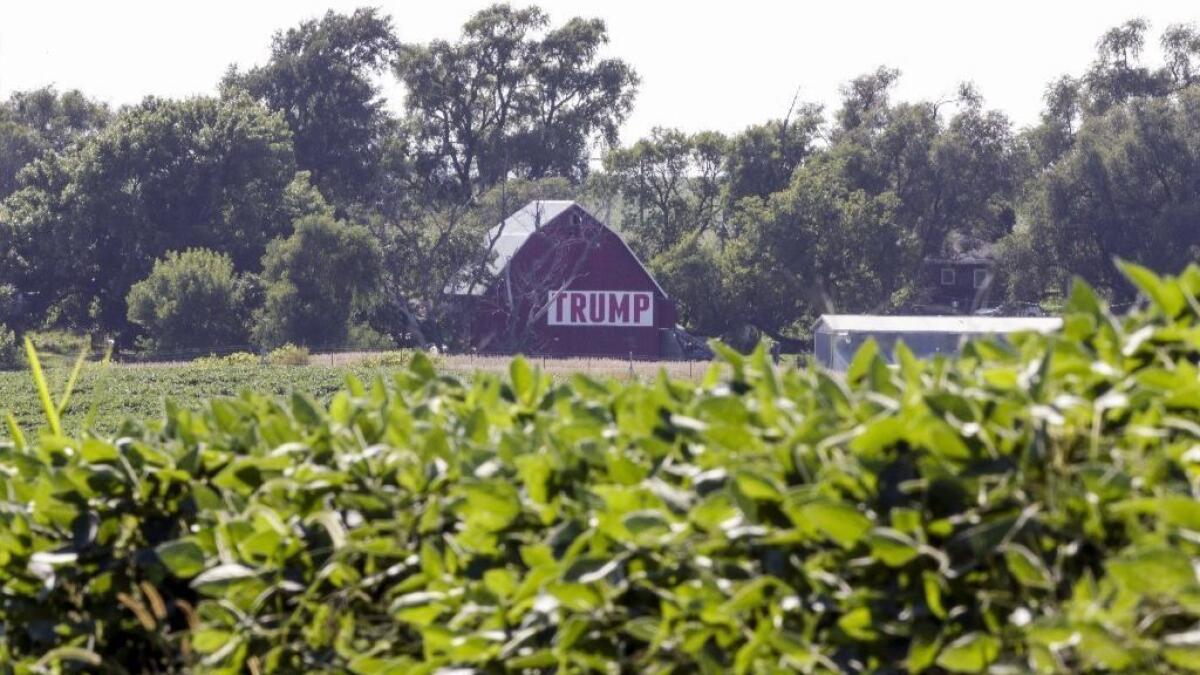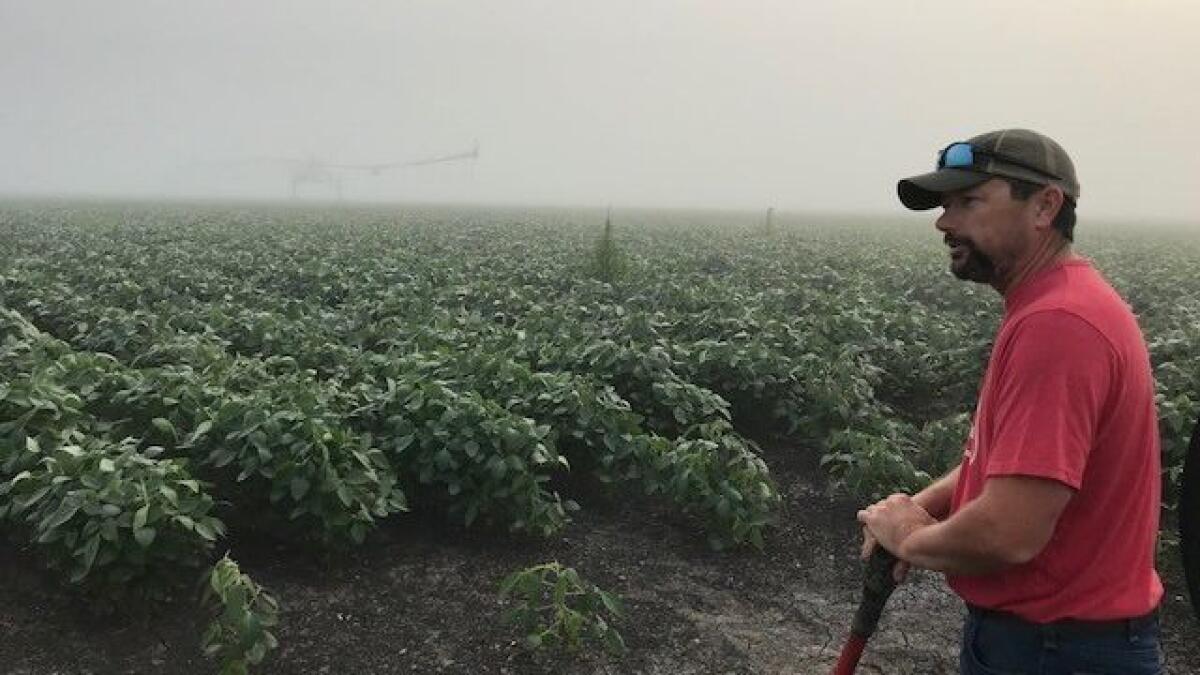In soybean country, Trump’s trade war with China tests patience and nerves

- Share via
Reporting from Trumbull, Neb. — Doug Saathoff, whose great-grandfather began farming around Trumbull, Neb., in the late 1800s, planted his first soybean in 1996 and hasn’t lost money since. Even droughts haven’t hurt because there’s plenty of underground water.
But that streak is in jeopardy, thanks to President Trump’s trade war with China, which has pummeled soybean exports and prices. Increasingly anxious about his family’s livelihood, the 44-year-old has taken small steps to save money, such as canceling satellite television and buying a used combine harvester rather than a new one.
One thing hasn’t changed: his support for Trump, whom Saathoff credits for taking China to task for its unfair trading behavior. He and some of his fellow farmers are willing to give the president more time to win concessions, betting that Trump won’t let things get really bad for American soybean farmers, who export about one-fourth of their crops to the Chinese market. But he also warned that their patience won’t last forever.
“He’s probably the only president who knew soybean farmers exist,” said the soft-spoken Saathoff. “I don’t know if we’re ready to rebel or not. But let’s just get the trade policy done.”
Saathoff can wait it out for at least a few more months partly because he was able to sell some of his fall harvest in advance, before soybean prices dropped. The question is: Will he and other farmers stick with Trump when they really start to feel the pain?
The economics and attitudes in this corner of the Nebraska plains provide some clues. As in other parts of the nation’s farm belt, most of these farmers have voted Republican for generations. They’re highly unlikely to abandon the party in droves.
Even so, Trump’s trade policies have sparked tensions in farm communities, in some cases dividing fathers and sons. And many farmers are getting restless as harvest season nears. Sen. Ben Sasse (R-Neb.) has been a frequent critic of Trump’s trade actions, calling some of his moves “dumb” and saying Trump is “threatening to light American agriculture on fire.”
Recent polls show an erosion of popular support for Trump from 2016, particularly in the Midwest and Great Plains. Just how upset farmers and others are may be revealed in some tight congressional races in the midterm elections.
“With Trump, we certainly do have a situation where that party loyalty is being tested,” said John Mark Hansen, a University of Chicago political science professor who has studied farm interest groups.
Few things are as important to America’s heartland economy as soybeans, whose growers stand to be among the biggest losers in a protracted trade fight with China. U.S. farmers shipped about $14 billion in soybeans to China in 2016, up from $1 billion in 2001. That makes soybeans one of the two top U.S. exports to China — the other is aircraft and parts.
As rising incomes in China have boosted that nation’s appetite for meat, the Chinese mostly use American soybeans as feed for livestock.
After Trump slapped tariffs on Chinese products this summer, Beijing fired back with retaliatory levies on U.S. soybeans and many other farm goods. In recent weeks, China has essentially halted new purchases of soybeans while moving to shift orders to other countries and providing incentives to its domestic farmers to produce more beans.
One result has been a drop in soybean prices, from about $11 a bushel earlier in the year to less than $9 today — the break-even point for many farmers.
Their worst fear is a permanent loss of the China business. Some of the older farmers remember what happened after Washington imposed a broad embargo of grain exports in 1973. Japan, worried about a stable supply of soybeans, reacted by making big investments in Brazil’s then-small soybean industry. Today, Brazil and the United States are the world’s two largest exporters of soybeans.
In speeches, Trump has called for patience, and has sought to soften the blow to farmers by offering $12 billion in emergency relief. Farmers here and throughout the country largely dismissed Trump’s offer as a handout that wouldn’t go very far, politically or financially.

“I don’t care what aid they give us,” said Merlin Radar, 83, who has been farming in the Trumbull area for more than 60 years. “We don’t want aid. We want trade.”
Radar, who said he remains a Trump supporter, meets regularly with his fellow farmers inside a former grain-elevator office in Trumbull, dubbed the Sugar Shack, to drink soda, play cards and shoot the breeze. On a hot August afternoon, the mention of Trump and his trade policies brought out a torrent of emotions.
“He’s gonna kill us,” groused Joel Samuleson, 81, noting the recent drop in soybeans. “What good is $2 off on bean price?”
Samuelson’s 56-year-old son, Eric, sat at the other end of a table looking askance at his father. “Yeah, it’s gonna hurt us for a while, but those beans gotta go somewhere,” he said, before turning to his feelings about Trump.
“I don’t like his persona necessarily, but he’s getting things done. The economy is going well, industry is growing, stock market is good,” Eric said. “I don’t like all his tweets; he’s kind of crude. But I’d rather have a person say what he thinks than what he’s supposed to say and lie through his teeth.”
“You don’t think Trump lies to us?” the elder Samuelson scoffed.
“They all lie,” Eric said.
About the only thing they all agreed on was their collective disdain for the administration’s plan to provide aid to farmers.
It was only about 20 miles from the Sugar Shack where Saathoff’s great-grandfather, who left Germany in 1877, took up farming, according to a family history by Saathoff’s grandfather, in which he writes about his father’s clan being “more of the rough type.”
Today, three generations of the Saathoffs work on a combined 3,500 acres, growing mostly corn and soybeans. Although the soil isn’t as dark and moisture-rich as in Iowa and Illinois, the two biggest soybean producers, Nebraska ranks in the top five, with its big aquifers helping produce far higher yields than the national average.
When a severe drought withered many soybean farmlands in 2012-13, Saathoff remembers the supply shortage, coupled with China’s growing appetite, pushing up bean prices to $17 a bushel for what turned out to be a bonanza for growers such as him.
“For me, it’s kind of nice to have a businessman in the Oval Office,” said Saathoff, a graduate of the University of Nebraska in Lincoln, where he met his wife, Gail. The couple and their two daughters, 11 and 14, live in a ranch-style house with a few cedar trees around it to provide a windbreak during Nebraska’s harsh winters.
Saathoff remains hopeful that Trump can improve the trade imbalance with China, but worries about the president’s erratic strategy: “One day it seems like things are going to get worked out. The next day they put more tariffs.”
Dawn was breaking as he drove his white Ford truck along a rocky, dirt road, past endless fields of soybeans. At one point, he stopped the pickup, pulled out his phone and checked the latest soybean price — $8.51, down a nickel, he said with a shrug.
Then he peered outside into the thick mist covering the area. “How long can I hold out?” he asked. “I don’t know.”
Twitter: @dleelatimes
More to Read
Inside the business of entertainment
The Wide Shot brings you news, analysis and insights on everything from streaming wars to production — and what it all means for the future.
You may occasionally receive promotional content from the Los Angeles Times.











